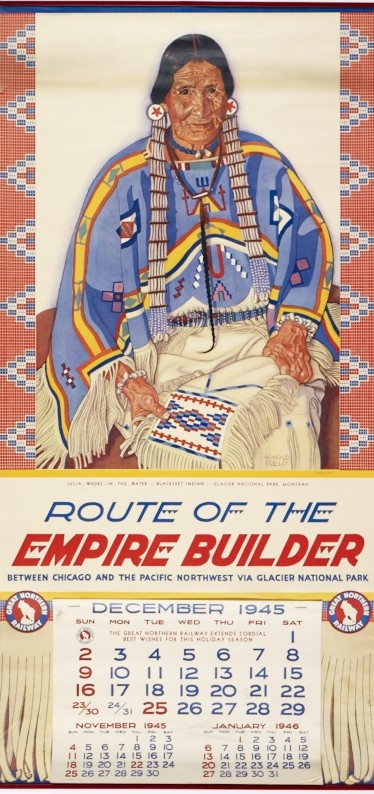INDIGENOUS PEOPLES THROUGH WESTERN EYES: VISITS TO THE WOLFSONIAN LIBRARY BY SOME COLOMBIAN SCHOLARS AND A GROUP OF YOUNG AFRICAN LEADERS
This past week, we had two sets of visitors interested in the native peoples and cultures of the American and African continents. The first set of visitors were Luz Helena Ballestas Rincón and José Jairo Vargas (professors teaching in the Escuela de Diseño Gráfico de la Universidad Nacional de Colombia). As I guided the two professors and their daughters through the galleries, Dr. Vargas was particularly impressed by a group of Art Deco commercial posters on display which had recently been donated to the collection by Avram and Jill Glazer. Where I have a tendency in my own tours to focus on the visual expression of the messages, Dr. Vargas was very much more interested in and animated by the particular techniques used in the printing processes.
Dr. Ballestas is a specialist in Native American art, having published (and donated to our library) a book on faunal imagery and symbols in the material culture of the indigenous peoples of her native Colombia. She was very interested in a series of New Deal mural studies on display that depicted North American Indians.
In anticipation of her library visit, I had pulled a variety of artwork drawing on the material culture of the Navajo, Pueblo, and Blackfeet Indian peoples.
One of the items I had chosen is an oversized portfolio titled Where the Two Came to their Father: A Navaho War Ceremonial. Jeff King (ca. 1865-1964) was born on the Navajo Indian Reservation in Pinedale, New Mexico where he was known in Navajo as Hashkeh-yilth-e-yah. King served as an U.S. Army scout between 1891 and 1911, and rose to prominence as a respected hataałii (singer of sacred songs, or medicine man). In that latter capacity, King performed a two-day long war ritual designed to protect the souls of the Navajo youth leaving the reservation in 1941 to fight for the United States in the Second World War. Maud Oakes, an ethnologist living on the reservation at the time, was granted permission to record the ceremony and the sand paintings. King’s text and Oakes’ paintings were published as a large-format portfolio, which included commentary by the famous mythologist, Joseph Campbell (1904-1987).
Other Navajo-inspired materials on display were several works on Navajo rug design and a series of English-Navajo language primers published by the Education Division of the U.S. Office of Indian Affairs under the direction of John Collier, Sr. During the presidency of Franklin D. Roosevelt, the Administration promoted a New Deal for the Indian that recognized native self-governance and tribal sovereignty over communal lands and reservations, stimulated the domestic production of carpets, blankets and other native handicrafts, and encouraged the Navajo to retain their native tongue while simultaneously teaching them English.
Written by Ann Clark, the Navajo primers describe the lives and seasonal responsibilities of native shepherds and include illustrations by Hoke Denetsosie.
The guests were also interested in a book on Frijoles Canyon Pictographs which recorded the symbols in hand printed woodcuts by Gustave Baumann.
But it was Handbook of Indian Dances, (a vibrant color block book about the Pueblo peoples published by Dorothy N. Stewart in Santa Fe, New Mexico), that really drew them in.
The Wolfsonian-FIU library also holds numerous books, portfolio plates, and Great Northern Railway commercial calendars reproducing Blackfeet Indian portraits made by German-American artist, Winold Reiss (1886-1953).
Later in the week, the library hosted a larger group of Sub-Saharan Africans visiting Florida International University as part of the Mandela Washington Fellowship for Young African Leaders.
The Wolfsonian museum collection is primarily focused on the period 1851 through 1945. Given Europe’s political, economic, and cultural dominance in the world in this era, much of what we have related to Africa is focused on military conflicts—such as the South African (or Boer) Wars—and materials documenting Italian colonial ambitions in Ethiopia and Somaliland. Much of our discussion consequently focused on propagandistic images of Africa and Africans produced in the context of colonialism. The library holds a couple of games designed to “educate” Italian children about the geography, history, and natural resources of Ethiopia, and to celebrate the conquests being carried out by their fathers.
Other items include a set of postcards illustrated by Aurelio Bertiglia (1891-?). These postcards use images of children in colonial uniform to emphasize the supposed “humanitarian” mission of the Italian colonizers, and to imply that the conflict was as bloodless as “child’s play.”
GIFTS OF STEVE HELLER
Many of the visitors were taken with the cover illustrations of Akbaba, a Turkish periodical that provided strong criticism of Italian dictator Benito Mussolini’s expansionist designs in the region.
PROMISED GIFTS OF MITCHELL WOLFSON, JR.
Thanks to the generosity of long-time library supporter Frederic A. Sharf, the library also possess a large number of original diaries, journals, photograph albums and sketchbooks documenting the earlier colonial struggles and conflicts in South Africa.
GIFTS OF JEAN S. AND FREDERIC A. SHARF
There are also hundreds of advertisements, brochures, and passenger ship menus in the library collection referencing travel to Africa. Not unlike the “native” themed calendar art of the Great Northern railway, much of these materials were designed to encourage European and American tourists to visit by emphasizing the “exotic” landscapes and peoples likely to be encountered on such trips.






























Well done!